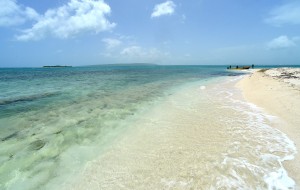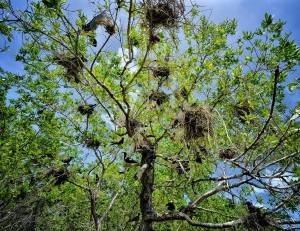The Portland Bight Protected Area (the PBPA) is the largest protected area on the island of Jamaica. It was created in 1999 by the Jamaican Government under the Natural Resources Conservation Act. It encompasses 1,876 sq km of coastal land and sea, including cays such as the Goat Islands. It is home to birds, iguanas, crocodiles, manatees, sea turtles and fish, as well as other flora and fauna. It includes three fish sanctuaries and endangered habitats such as dry limestone forest and mangrove.
This large area of diverse landscapes and natural treasures is now threatened by reported plans for a proposed logistics hub/trans-shipment port to be constructed by China Harbour Engineering Company. There is a petition site where you may register your concern about this here: http://chn.ge/1ecZdCO I urge you to sign and share with your friends and contacts who care about our increasingly fragile environment.
On August 23, environmentalists and civil society groups announced that they plan to take legal action against the Jamaican Government (the Ministry of Land, Environment and Climate Change and the Attorney General) after the Minister of Environment himself signaled that the project is under consideration, during a visit to China. Since then, very few details have been forthcoming; but much of the discussion has been on the outlying Goat Islands only. However, it must be emphasized that any bulldozing of the islands or dredging of the surrounding marine environment would have a devastating effect reaching far beyond this area. At this point we do not know how much larger the project plans are, although it has been reported that CHEC are looking for a total of 3,000 acres for the logistics hub. We still await details from the Jamaican Government.
DID YOU KNOW?
- The Society for the Conservation and Study of Caribbean Birds (SCSCB) has posted an extensive, beautiful photo album of the PBPA, compiled by U.S.-based naturalist Ted Lee Eubanks – 100 images! You can see this at their Facebook page (Caribbean Birds) and I am sharing a few photos below (although this blog format does not do them justice). The link to this wonderful photo album is http://tinyurl.com/mnmmpt9
- Jamaica is one of eight countries that has committed to The Nature Conservancy‘s Caribbean Challenge Initiative. This means Jamaica has committed to conserving at least 20% of its nearshore marine and coastal environments in national marine protected areas systems by 2020; and to creating a National Conservation Trust Fund endowed by new sustainable finance mechanisms (such as tourism fees), dedicated to solely to funding park management. Jamaica’s commitments (and those of private sector supporters, such as Sandals Resorts/Sandals Foundation) are here: http://www.nature.org/ourinitiatives/regions/caribbean/cci-summit-commitments.pdf As The Nature Conservancy notes, “With 70% of the population living along the coast, Caribbean lives and livelihoods directly depend upon healthy marine and coastal resources. Alarmingly, the Caribbean is increasingly threatened by development, pollution, overfishing and climate change.”
- The Portland Bight wetlands and cays are one of four designated RAMSAR sites in Jamaica, since 2006. According to the National Environment and Planning Agency (NEPA), a government agency, “The site has significant value for the country. Notably there is a range of endemic and rare plants, extensive fish life and several small coral cays.” Jamaica is a signatory to the Ramsar Convention on Wetlands of International Importance (since 1998). Note that part of one of the Jamaican RAMSAR sites, the Palisadoes – Port Royal Protected Area, was bulldozed and destroyed during the reconstruction of the airport road in 2010 through a project funded by the China Exim Bank. Jamaica’s Supreme Court ruled that NEPA breached the legal standard for the holding of public consultation for the development.
Please find below more information on this remarkable area, now threatened by development, and the great efforts of non-governmental AND government agencies, as well as overseas entities, to preserve and sustainably manage its resources:
Since the PBPA was created, it has been managed by the non-governmental organization Caribbean Coastal Area Management Foundation (C-CAM), which works with various government agencies and non-governmental organizations to ensure that the area is protected. Most importantly, C-CAM works closely with residents and other stakeholders – including farmers, fisherfolk, business people and landowners – through continuous outreach. Residents learn about – and implement – climate change mitigation, sustainable fishing, forestry and farming practices, such as rainwater harvesting. The aim is to contribute to the local economy sustainably, while improving the quality of life of residents.
C-CAM’s programs in the PBPA include a Biodiversity Conservation Program, and special attention to the dry limestone forest of the Hellshire HIlls, Portland Ridge, the Brazilletto Mountains and Kemps Hill. There is also some of this very special habitat on the Portland Bight Cays. This forest has close to 300 plant species, including 53 endemic species – that is, they exist nowhere else in the world. Why are plants important? They have many purposes and uses for humans, including their often unexplored medicinal potential. The Forestry Department has recommended that all of this precious and increasingly rare habitat be set aside for conservation purposes.
The critically endangered Jamaican Iguana also lives in the dry limestone forest. It was actually considered extinct until 1990, when it was rediscovered. The Jamaican Iguana Conservation Programme has been supported by a number of local and overseas agencies, including the International Iguana Foundation, Hope Zoo, San Diego Zoo, Fort Worth Zoo and several other zoos in the United States. The fate of this amazing and unique creature still hangs in the balance, however, due to destruction of habitat and predators such as domestic dogs. Head of the Iguana Recovery Group Dr. Byron Wilson, of the University of the West Indies, observes, “We must keep up the fight, because otherwise, the iguana will drift into extinction.” Gone forever.
C-CAM also has a Cave Conservation Programme (there are 53 known caves in the protected area, some with unique species). It established a Fisheries Management Council in 1995 to work on the many challenges for fishermen – including over-fishing, coral reef degradation, pollution and invasive species (C-CAM spearheaded a major public education program on the invasive Lion Fish, for example). With the support of government agencies, including the Ministry of Agriculture and Fisheries and organizations such as the California-based Seacology and UC-Rusal, three Special Fisheries Management Areas were established in 2010. C-CAM works with local gun clubs to control game bird shooting in the area; and with the government’s NEPA on a Watershed Management Programme. The United Nations Food and Agriculture Organization (FAO) has also partnered with C-CAM on a Climate Change Adaptation Programme, along with two government agencies – NEPA and the Planning Institute of Jamaica – in Old Harbour and Portland Cottage in particular. The coastal area is particularly vulnerable to storms.
I hope that all of this helps you to understand some facts about the Portland Bight Protected Area and that you will explore further. I do hope that wisdom will prevail.
A couple more articles:
http://repeatingislands.com/2013/09/04/i-live-for-art-an-ecocide-romance-on-youtube/ “I live for art: an ecocide romance” on YouTube: repeatingislands.com
https://petchary.wordpress.com/2013/08/24/protecting-our-fish-earth-day-part-1-2/ Reblog from April, 2012: Opening of field office for fish sanctuaries, Salt River
http://www.jamaicaobserver.com/environment/Six-reasons-against-port-on-Goat-Islands_14960085 Six reasons against port on Goat Islands: Jamaica Observer
http://www.jamaicaobserver.com/environment/Jamaican-Iguana-fighting-for-survival_15000242 Jamaican Iguana fighting for survival: Jamaica Observer
The following links will provide more information on SOME of the partnerships that support/have supported this protected area:
http://www.nature.org/ourinitiatives/regions/caribbean/cci-summit-commitments.pdf Commitments Announced at the Caribbean Summit of Political and Business Leaders under the Caribbean Challenge Initiative (CCI) (British Virgin Islands; May 17 – 18, 2013)
http://larc.iisd.org/news/caribbean-states-become-biodiversity-champions/ Caribbean states become biodiversity champions: International Institute for Sustainable Development
http://www.nature.org/ourinitiatives/regions/caribbean/caribbean-summit.xml Inaugural Caribbean summit rallies support for conservation: The Nature Conservancy
http://www.seacology.org/project/60-jamaica/ Seacology project in Portland Bight/Jamaica
http://www.iguanafoundation.org/s18-107-Jamaican-Iguana-Project.aspx The International Iguana Foundation/Jamaican Iguana Project
http://www.nature.org/ourinitiatives/regions/caribbean/jamaica/index.htm The Nature Conservancy Caribbean Challenge Initiative: Jamaica
http://glispa.org/?page_id=363 Global Island Partnership: Caribbean Challenge Initiative
http://www.caribbeanbirdingtrail.org/partners/jamaica/ Caribbean Birding Trail: Partners – Jamaica
http://www.ramsar.org/cda/ramsar/display/main/main.jsp?zn=ramsar&cp=1-30-168%5E16567_4000_0__ The Annotated RAMSAR List: Jamaica
http://www.greenantilles.com/2011/12/09/wetlands-of-international-significance-in-jamaica-a-new-one-has-been-designated-another-is-being-disfigured/ Wetlands of international significance in Jamaica: A new one has been designated, another is being disfigured: greenantilles.com
All the photographs below, all taken in the Portland Bight Protected Area, are by Ted Lee Eubanks. Thanks so much to Ted for sharing these! The full album of 100 photos can be found at the “Caribbean Birds” Facebook page.














Agreed. But a reality . Is this because citizens are uncertain or fearfull of change that could threaten special interests ; alternatively are they unconvinced of the urgency of the mission.? Is there anything more we can do, or do differently?
LikeLike
Jamaican citizens do take it very slowly when it comes to taking action. They are aware of the issues but unless it directly affects them they will not get up and do something. It’s for someone else to sort out. It’s hard to say what more we can do at the moment, apart from write about the threat to this beautiful area (you can also arrange to visit, by boat, if you are in Jamaica), talk to people about it, write about it, buy a Save Goat Islands T shirt or desk calendar to support the cause, sign the petition. The Government continues in its determination to block ANY information on the project. A court case for access to that information is still under way but the action will not be heard until June! Yes, June… Meanwhile, silence from the Government.
LikeLike
This is the most amazing story about another of Jamaica’s treasure of endangered species and their often reluctant preservation.
LikeLike
Thank you! “Often reluctant” is really an understatement!
LikeLike
Can’t stand hearing about things like this. Always remember the oil industry and the west coast of Canada – they’re still threatening to build pipelines through the most pristine, unspoilt landscape. Off to sign this and share!
LikeLike
Thanks so much, Russell! It is great to get support from Down Under! I much appreciate your support and yes, we do need to spread the word. It is so sad that these beautiful places around the world are now threatened. And once they are gone, they are gone!
LikeLike
Very interesting however it makes you wonder why tourism is not expanded to these part of the island.
LikeLike
Well, the traditional mass market tourism has not reached this part of the island because it would obviously cause environmental problems in an area that is protected by law. And look at what mass tourism did to the north coast, and in Whitehouse, where much precious wetlands (which are nurseries for fish and birds) were destroyed. But I do agree that there is much potential for eco-tourism here – it is a major part of Costa Rica and Belize’s tourism among other countries in the region, and tourists are becoming much more environmentally aware. They don’t want to go abroad and see concrete. Eco-tourists usually have more money, too!
LikeLike
Signed and on Facebook.
LikeLike
Thank you so much! Really appreciate your support…
LikeLike
Signed, shared and tweeted!
LikeLike
You’re a darling, Jack. We need thousands more signatures! Much appreciate your support.
LikeLike